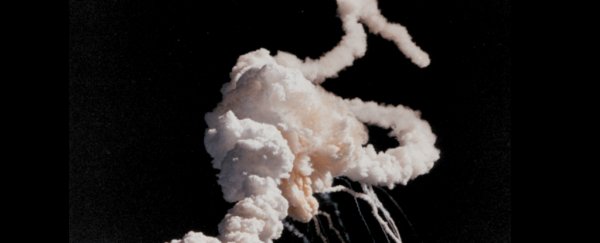This article was written by Monica Grady from the Open University, and was originally published by The Conversation.
It was one of those moments you'll never forget. Thirty years ago, the Challenger space shuttle exploded 73 seconds after launch. In an instant, a dream became a tragedy – and all because a small, simple seal had failed in the right solid rocket booster.
I remember the event well. I had a dark cubbyhole of an office overlooking a doorway that was a short-cut between our offices and the bar, where there was a television. At just after five o'clock, when I was thinking of packing up for the day, a colleague banged on my window. "The shuttle has exploded," he said. "We're going to see if there's any news on TV."
He had heard a news bulletin on his radio and wanted to find out what had happened. It's all too easy to forget now that in those days you couldn't just do a quick internet search or flick over to the news channel. The news was broadcast at specific times – and the BBC evening news was not on until 6pm.

I saw the first film footage of the disaster on the children's news programme, Newsround – appropriate since the mission was the first to have a teacher, Christa McAuliffe, on board, and Newsround had been following the build-up to the launch.

Like millions of others, I hoped that the appearance of several streaks from the shuttle signified that the seven-strong crew had escaped and would soon be rescued from the Atlantic Ocean.
But, as is well-known, that was not the case – and the subsequent Rogers Commission found that Sharon Christa McAuliffe, Gregory Jarvis, Judith A. Resnik, Francis R. (Dick) Scobee, Ronald E. McNair, Mike J. Smith and Ellison S. Onizuka were likely to have either died from hypoxia during their return through the atmosphere, or on impact with the water surface. They were the first American astronauts to die in flight.
 NASA/Reuters
NASA/Reuters
Since then, there have been advances in communication that have changed the world almost beyond recognition. We no longer have to wait for a news bulletin to receive information, or go to a specific location to watch footage of an event. We carry the news with us – mobile phones and social media give 24/7 access to world events, relaying images and commentary from one side of the globe to the other almost instantly. But has space travel changed that much?
A global calamity
That Challenger mission was the 25th to take off as part of the main Shuttle Transportation System (STS) program. Its launch came at a time when almost every launch was a mission "first", whether it featured the first American woman, the first African-American, the first European, the first politician. Interest in STS-51-L was particularly high, because school students had followed selection of Christa McAuliffe from 11,000 applicants as part of the Teacher in Space Project. US president Ronald Reagan's subsequent speech – paraphrasing John Gillespie Magee's poem High Flight – expressed the enormity of the calamity.
"We will never forget them, nor the last time we saw them, this morning, as they prepared for their journey and waved goodbye and 'slipped the surly bonds of Earth' to 'touch the face of God'."

The shuttle program was suspended for almost three years and, following its re-introduction, flew 88 successful missions in 14 years, most of which were to build and supply the International Space Station (ISS). The Columbia disaster of February 2003, when the shuttle disintegrated on re-entry, killing all seven crew, again halted the program. One of the most damning findings of the Columbia Accident Investigation Board was the criticism of NASA's decision-making, its risk assessment procedures and its organisational structures – concluding that NASA had failed to learn many of the lessons from Challenger.
 Reuters
Reuters
The shuttle program ended in 2011, at first leaving supply of the ISS dependent on the Russian Soyuz and European Ariane rockets. Latterly, the private companies SpaceX and Orbital Sciences have also been contracted to transport cargo to and from the ISS.
Where next?
So what is the legacy of Challenger? Have we taken on board all the advanced safety requirements that followed the two shuttle disasters? Have the recommendations on organisational change been followed? Sadly, until there is another disaster, we probably won't know. But with every successful launch that takes place, we can be more certain that spaceflight – at least unmanned spaceflight – is becoming more routine.
On the other hand, human spaceflight as a regular, accepted mode of travel is seemingly as far away as it was in 1986. The arrival of private companies on the scene has given more impetus to the idea that space travel for pleasure is achievable – but the crash of Virgin Galactic's SpaceShip Two in November 2014 again questioned the safety of such enterprises.
There is a Global Space Exploration Programme and NASA has reaffirmed its commitment to human exploration of Mars. Meanwhile, ESA's director-general, Johann-Dietrich Woerner, has declared that he wants to build a village on the Moon, probably using 3D printer technology, and that it should be a global village for all nations. But the truth is that many of the documents associated with these ventures are aspirational rather than realistic.
Future visions of human space exploration are either inspiring or laughable, depending where you sit on the optimism-pessimism scale. But they do give us something to strive for – and surely that is the best lesson to take from Challenger, and a fitting tribute to those who have lost their lives in space. Never give up, we'll get there in the end. And the views will be breathtaking.
Monica Grady, Professor of Planetary and Space Sciences, The Open University.
This article was originally published by The Conversation. Read the original article.
